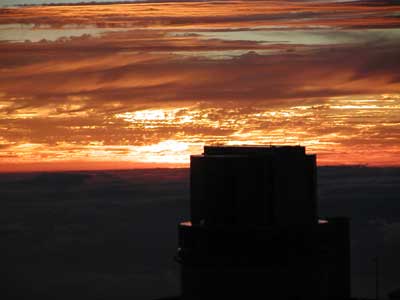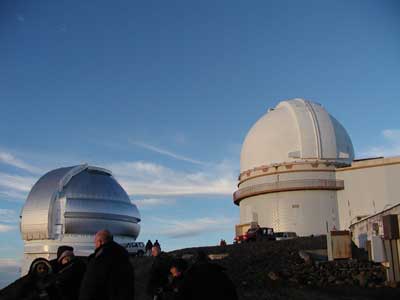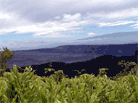Mauna Kea Observatories
When most people think of Hawaii, they think of beaches, mountains and
the hula. Maybe they think of roast pig. When astronomers think of
Hawaii, they think of telescopes and observatories. Who said
astronomers are normal people?With 14,000 foot high mountains and generally sunny weather, the Big Island of Hawaii is one of the world's pre-eminent places for siting a high powered telescope. The good weather means good viewing, and the high altitudes mean less air to block the light. There will be more on this later.
You can drive your rent a car up Mauna Kea to check out the observatory farm, but we decided to take one of the tours. We didn't want to be exhausted driving down after dark, and we also wanted to have a guide who could tell us what we were looking at.
We were soon bounding up Saddleback Road which was built by the military during World War II, or so we were told. It is not clear if anyone has done any maintenance since. We were near the high point of the saddle that divides the east and west parts of the island when our driver took a turn off and we were soon climbing in earnest. We were soon at 9,000 feet and stopped for sandwiches and services at the visitor center. The air was cold. The afternoon was moving on. We could already feel that strange fatigue that signals thin air.
Refreshed, we resumed our ascent and got tantalyzing glimpses of the sea. Then, we were up among the observatories. They are all white and silver and it is hard to tell the scale of things. The barren summit provides few clues. We stop at a promising view point. The sun sets later up here, but already, the light is growing redder. We can watch the orb of the sun approach the horizon. The white observatory domes take on a ruddy tint.
We are all breathing deeply, even as we are standing still. Walking across the parking lot is a challenge. The air is so thin that it is an effort to think. As the light fades, it gets colder. The orb of the sun passes below the horizon. The light continues to fade. It is getting colder and colder.
The sunset is spectacular. You can see for hundreds of miles from the summit of Mauna Kea and the horizon stretches in all directions. Only Mauna Loa to the south stands out.
After sunset, we hustle back to the van and head off for some more viewing. You can't just stick your eye to the eyepiece of one of those big scopes, at least not off the internet. There is no WiFi on the summit. Besides the big scopes cost millions of dollars to run and most of them use exotic sensors and powerful computers to analyze the light and make sense of it. Astronomers call them "light buckets" because they collect light. Then it their job to figure out what that light means.
We descend a bit and pull off the road to a grassy field. Our guides pull out a couple of telescopes, simple refractors. At this altitude it is hard for an amateur to tell a Schmidt from a Cassegrain. They apologize for the wretched viewing. We have the worst of both worlds. The light of the full moon drowns out all else and the cirrus clouds block our view.
It was awful. We could see the moons of Jupiter. We saw several shooting stars. One of us even saw one through the telesope. We saw double stars. We saw Saturn. We saw some ring nebula. It must have been the thin air, because we kept saying things like, "amazing", "wonderful", "beautiful".
By now, the thin air was beginning to tell. It was time to fire our retro rockets and return to earth. We stumbled back to the van, cold, tired and exhiliarated.
It was not long before the air grew thicker. It was rich, sweet, humid and scented with flowers by the time we neared our hotel. What an amazing journey. It was physically and mentally taxing. Already, we are planning our return to space.

One of the observatories and those cirsus clouds

The sky in flames

The fiery sunset

Looking down towards the coast



